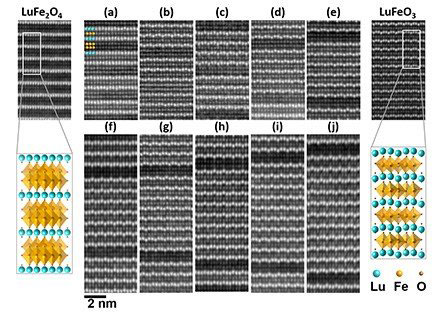| Posted: Jun 14, 2017 |
Electrifying magnetism by assembling alternating atomic layers of two oxide materials
(Nanowerk News) As computers and cell phones become smarter and faster, they use more electricity. More electricity means more heat. Dispelling that heat uses more energy. New materials that couple electric and magnetic states of a material could break this cycle.
|
|
Scientists created a new material that displays electrically controlled magnetism at room temperature. They created the material by assembling alternating atomic layers of two oxide materials. They exploited geometric factors and atomic lattice distortions between the alternate materials (Nature, "Atomically engineered ferroic layers yield a room-temperature magnetoelectric multiferroic").
|
 |
| New materials with unique and useful properties can be made by taking materials with different desired properties and layering them at the atomic level. In this research, scientists made new materials by alternating layers of a material with special magnetic properties (LuFe2O4 (left)) and a material with special electronic properties (LuFeO3 (right)). Panels a-j show high-resolution images of the resulting “superlattice” structures for materials with 1 (a) to 10 (j) atomic sheets in the layer made up of the ferroelectric LuFeO3. The more atomic sheets in the layer, the more atomic level “rumpling” of the structure — indicated by the wavy appearance in the images — that drives the superlattice properties to allow electrically controlled magnetism at room temperature. Lutetium (Lu), iron (Fe), and oxygen (O) atoms are colored turquoise, yellow, and brown, respectively. (Image: Megan Holtz)
|
|
The study provides the insights needed to make materials with both magnetic and polarizable electronic properties at room temperature. With this research, scientists can now engineer artificial materials that have the desired properties. These materials could improve memory storage devices and sensors.
|
|
It is rare to find materials that operate at room temperature and display strong “multiferroic coupling” — a property that allows an electric field to control the direction of the electronic spin and a magnetic field that controls positive/negative electronic charge. Thus, the material has both ferroelectricity and ferromagnetism.
|
|
Now, scientists have designed a new material that can operate at room temperature (281K). Using a synthesis approach with atomic control called molecular beam epitaxy, the team assembled an artificial material with alternating layers of lutetium iron oxide (LuFeO3, a ferroelectric material) and LuFe2O4 (a ferrimagnetic material).
|
|
The team varied the number of atomic sheets in the LuFeO3 layer from 1 to 10. With 9 atomic sheets in the LuFeO3 layer, they induced a ferroelectric state in the LuFe2O4 while simultaneously increasing the magnetic transition temperature from 240K (-27 F) in LuFe2O4 to 281K (46 F). The ferroelectric coupling to ferrimagnetism enables control of the magnetism by electric fields at 200K (-100 F).
|
|
The team used methods insensitive to magnetic impurities (e.g., neutron diffraction) or electrical leakage (e.g., high-resolution electron microscopy) to substantiate the results, which were consistent with first-principles calculations.
|

